OT Corner: Callirobics For Kids – Writing Skills With Music
Editor’s Note for Full Disclosure: Sarah and I met with Liora Laufer of Callirobics last April at AOTA. Sara and I offered to review Callirobics on PediaStaff. A free copy of the Callirobics program was provided to Sarah at that time. The contents of this review and all opinions expressed herein are Sarah’s own.
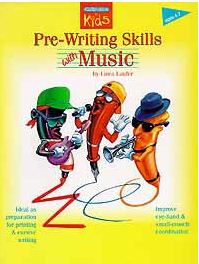
by Sarah Gerard, OTR/L
Music shows to be a highly motivational tool for children. How many times have you caught yourself singing to your children to get them to eat, transition between activities, go to the bathroom or go to bed? How about to write? There are handwriting programs out there that incorporate music to provide verbal cues on how to hold your pencil, where to start your letters, what the helping hand does, etc. They can be a catchy and useful way to provide verbal cues for learning the basic functional skills of handwriting.
Callirobics, founded by Liora Laufer takes a different approach to music and handwriting. She utilizes the rhythm of familiar music to help teach the basic strokes and movement of handwriting. Her workbooks and music are available for anyone from beginners just learning their letters, all the way to adults looking to regain small muscle coordination and handwriting skills. I loved the idea and decided to try the pre-writing program for ages 4-7 with one of the kiddos I work with on handwriting skills. We had tried other approaches and I was curious to see how he did with this novel approach.
Participant:
The kiddo I decided to try this with is a 7 year old boy with spastic quadriplegia cerebral palsy (CP). Before starting the program he could already recognize his letters and he knew how to form them independently, but his overall control and eye-hand coordination when actually writing the letters was extremely difficult for him. When writing, he often had unnecessary pointing or rounding, gaps, overlapping, sizing and placement difficulties with his letters. In addition to the motor control challenges with his writing, his attention to writing tasks was a challenge causing his control to decrease with continued writing throughout the session. Overall his writing was often illegible.
What Does The Program Involve:
Callirobics uses its workbook and cd as a prep tool for printing and cursive writing by helping its users to improve their visual and fine motor coordination with the aid of music. The workbook pages are excellent because they are simple and not visually over-stimulating to the user. The user gets the opportunity to practice tracing different horizontal, vertical, diagonal and curved patterns (1 pattern per page) for 3 lines and then carry it over for 1 line without tracing. What’s great is there is no actual letter writing involved, which cuts down on the stress of having to create a specific letter and allows them to practice control and coordination through repetitive patterns. The music does a great job of not setting the pace for writing, but instead providing a rhythm to supplement their own individual pace. Each worksheet is meant to be completed a minimum of 3 days in a row, but you can judge whether or not to stay on a worksheet for longer in order to make it more intensive and allow the child more repetition. As a bonus, there’s also a coloring page included with each exercise, with a hidden pattern incorporated into the picture at the beginning of each exercise.
Participant’s Progression Throughout the Program:
Here is a quick look at our journey through the program. Initially there was a large amount of difficulty with tracing the lines. He would lift his pencil often, instead of completing one continuous line. He began with completing the same worksheet for 3 days in a row and then moving onto the next. We discovered, because of his large challenges with motor planning and control, that he had more carryover when we did the worksheets for a full week at a time (5 days in a row). We decided to keep him at this frequency because of the improvement. He enjoyed the program because of how quick it was to complete the program and that music was incorporated into it. The first couple of days he was slightly distracted by the music and needed cues to redirect his attention back to the worksheet, but by the end of the first week he was able to better sync up listening to the music and writing. Towards the end of the program his overall control with handwriting improved. Because of his diagnosis and multiple challenges, his control with writing is still a continued concern. What’s great is that we can go back and repeat the program after a brief break and continue to see improvements that carryover after each completion. Sample pictures of both the completed worksheets and his handwriting from our first go around with the program are provided below.
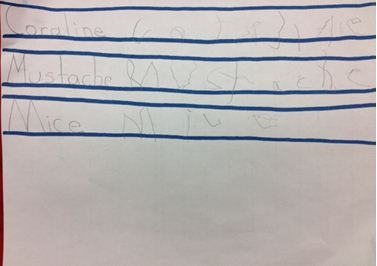
Writing sample before the program
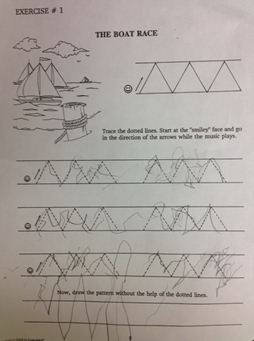
1st Exercise that was done at the beginning of the week
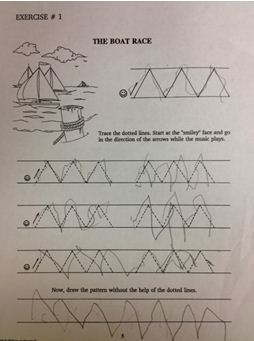
1st Exercise that was done at the end of the week
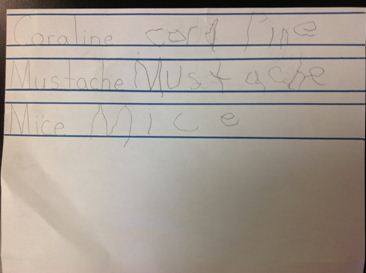
Writing sample after the program
Great Things About the Program:
Here are the biggest pros I discovered while using the Callirobics program:
- Quick: The program literally only takes around 5 minutes a day (depending on the speed of the child using it). It’s quick enough that if the same worksheet is done on a day to day basis, it’s better tolerated by the child. There are no restrictions to how many days in a row you can complete the worksheets, so if it’s a specific one the child loves, it’s ok to let them do more.
- User Friendly: The workbooks give some great ideas on how to switch up completing the worksheets so that it is more interesting for the kids. This program is very user friendly because it allows you to adapt the exercises to the child’s needs rather than having a strict structure. It can be used alongside other hand writing programs as well.
- Familiar Tunes: The kids recognize the music, so they are often more willing to complete the worksheets. Songs such as “Row Your Boat” and “London Bridges” are just two of the songs incorporated into this workbook. The music makes it more motivating to complete the worksheets and provides that auditory cue to help them correctly complete the patterns.
- Visual Cues: The patterns on the worksheets have small smiley faces to show where you start each of them and arrows pointing in the direction that you would follow. I found that I had to give just one verbal direction to “remember to start at the smiley face” and he was able to initiate starting at the smiley face for the rest of the patterns on the worksheet.
Some Points To Consider:
- Sequencing Of Worksheets: The patterns on the worksheets are great examples of pre-writing strokes. The order of the worksheets was found to be somewhat difficult for the kiddo that completed the program because it began with diagonal lines, went to curved lines, than horizontal and vertical connections and continued with looping lines. Since some of the later patterns are actually easier for kids to create, this kiddo had an easier (and more accurate) time with some of the later exercises than the earlier ones. Since all the worksheets and songs are numbered, it is possible to complete the exercises out of order if desired, in a progression that works better for your child to allow growing success and limit the chance of frustration.
- No Verbal Cues: The workbook doesn’t come with specific verbal cues to help teach the patterns. For kids that have difficulties motor planning, verbal cues may be necessary in order to assist with the motor planning to complete the practice pattern at the top of the worksheet. I was able to make up some of my own word plays in order to teach the formation of the patterns on ones my kiddo had more difficulty with and I stayed consistent in the vocabulary I used, so that there was carryover throughout the program. Not every child needs verbal cues though and the visual and rhythm cues may be enough, just something to consider for those children that do better with verbal cues. What is nice is that the title for each worksheet is designed to help the kiddos recognize the pattern for that sheet.
- Size: The height of the lines that the children are writing in are about ¾ of an inch. This was found to work well for the simpler patterns, but showed to be more difficult for my kiddo as the patterns became more complicated. You may find you need to enlarge some of the worksheets or complete the patterns in an alternative method depending on the level and needs of the kiddo.
- Allow a Grace Period: Depending on the distractibility of the kiddos you work with, they may be more tuned in to the music than the task in the beginning. You can counteract this by letting them listen to the music once through and then doing the page or adding extra days on for each page. The distraction should decrease with each day. Because of the simplicity of the program and its ability to complement other programs or techniques out there, I recommend using it all the way through once and then making a decision on whether or not to use it again with that particular kiddo.
The Outcome:
I found that there is an immediate carryover of increased overall control, in the writing of the kiddo that completed the program. This kiddo has shown to progressively become more accurate with tracing the patterns and then carrying it over to his actual letter writing. He did best when the same worksheet was done for a week straight in order to increase his repetitions for motor planning and control of the pattern. The music was motivating for him and he was able to complete the worksheets day to day without avoidance. Callirobics works on that overall control, but in a way that doesn’t seem like they are handwriting. Since the program is so open to interpreting and completing it in the way that best fits your child, it is one that can be used for a variety of different kids. For more information on the Callirobics for Kids program go to www.callirobics.com.
About the Author: Sarah Girard, OTR/L of Starfish Therapies
Sarah graduated from the University of New Hampshire with her Masters degree in Occupational Therapy. She has experience working in pediatric sensory integration, early intervention, adolescent psych, and school based settings. Sarah has traveled to Mexico where she volunteered at a local orphanage treating children with various developmental disabilities and educating staff members in how to follow through with recommended treatments. She is Handwriting Without Tears certified and has been trained in Sensory Integration and Praxis Theory, The Alert Program “How Does Your Engine Run?”, Vital Links Listening Program, Sequential Oral Sensory (S.O.S.) approach to feeding and Vestibular Rehabilitation. Sarah has begun training in the Masgutova Neuro-sensory-motor Reflex Integration (MNRI) Method. Sarah enjoys working with children as well as her time spent working with Occupational Therapy students in her role as a fieldwork educator. She currently works for Starfish Therapies.
Please support PediaStaff contributors and visit Starfish Therapies.
PediaStaff is Hiring!
All JobsPediaStaff hires pediatric and school-based professionals nationwide for contract assignments of 2 to 12 months. We also help clinics, hospitals, schools, and home health agencies to find and hire these professionals directly. We work with Speech-Language Pathologists, Occupational and Physical Therapists, School Psychologists, and others in pediatric therapy and education.
